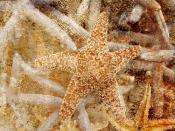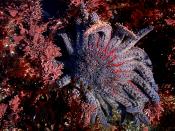~ Classification
The kingdom is anamalia, phylum - Echinodermata, class - Asteroidea, order - Phanerozonia, family - Goniasteridae - Oreasteridae - Asteropseidae - Ophidiasteridae - Asterinidae - Asteriidae. As you see there are many types of seastars. Genus - Fromia, Species - Choriaster granulatus .
~ Habitat
The northern pacific seastar is commonly found in sublittoral to subtidal areas, but also occurs in water depths down to 200m. It is rarely found on reefs or in areas with high wave action, instead happily settling on either mud, sand or pebble substrates. In Tasmania, juveniles and adults have also been found attached to scallop longlines, spat bags, mussel and oyster lines, and salmon cages. In its native range, the seastar prefers water temperatures between 7 and 10o C, but has adapted to warmer waters (up to 22o C) in Australia and other countries.
~ Prey & Predator
The northern pacific seastar is a voracious predator and will eat almost any animal tissue it can capture.
However, the seastar has a particular fondness for shellfish, whose flesh it eats after prying their shells open with its arms. This preference for shellfish poses a serious threat to mariculture and wild shellfish fisheries. The seastar is also capable of detecting food from some distance away and will dig shallow pits to extract buried prey. The seastar is a large voracious predator, reaching sizes 40 to 50cm in diameter.
~ Systems
*Respiratory: This is a diffusion type. Oxygen diffuses into the coelomic fluid from seawater at the skin gills.
*Digestive: Digestive waste is eliminated through the anus. Nitrogen waste is carried by amoebocytes that inhabit the coelomic fluid. The amoebocytes take the nitrogen waste to skin gills. From the skin gills, the nitrogen waste diffuses into seawater surrounding the starfish. Carbon...


